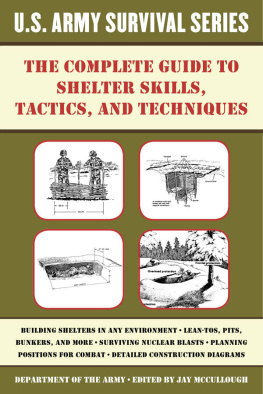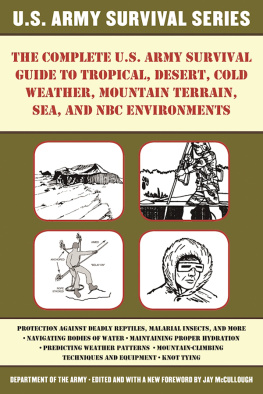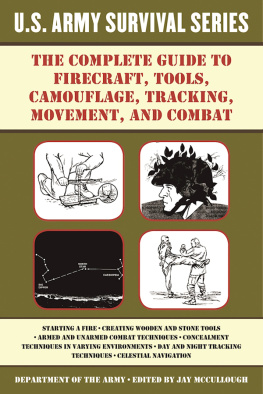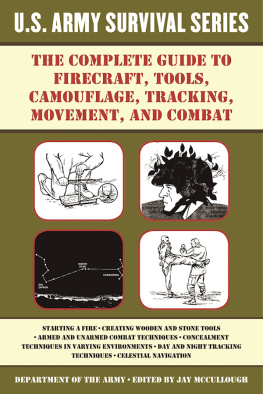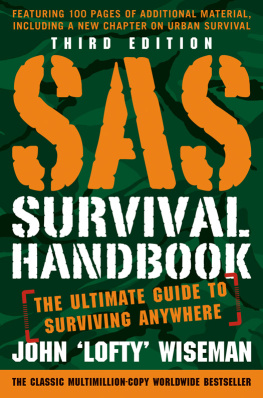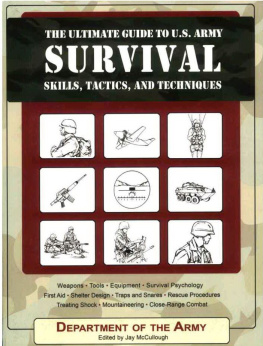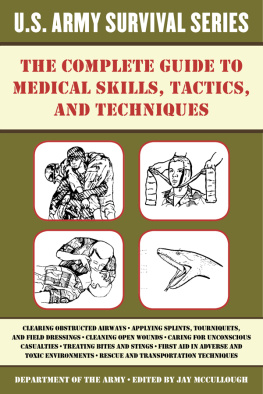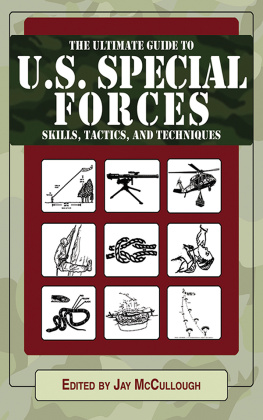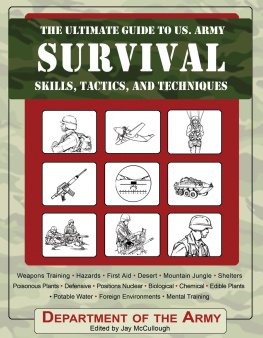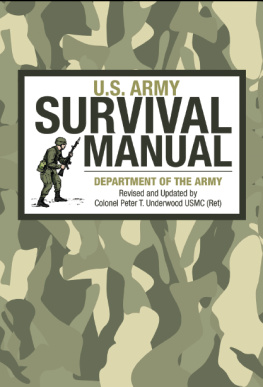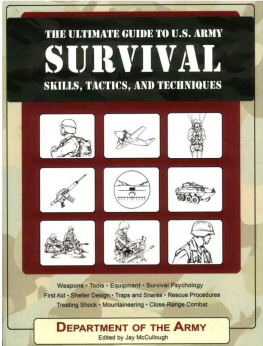Jay McCullough - The Complete U.S. Army Survival Guide to Shelter Skills, Tactics, and Techniques
Here you can read online Jay McCullough - The Complete U.S. Army Survival Guide to Shelter Skills, Tactics, and Techniques full text of the book (entire story) in english for free. Download pdf and epub, get meaning, cover and reviews about this ebook. year: 2016, publisher: Skyhorse Publishing, genre: Children. Description of the work, (preface) as well as reviews are available. Best literature library LitArk.com created for fans of good reading and offers a wide selection of genres:
Romance novel
Science fiction
Adventure
Detective
Science
History
Home and family
Prose
Art
Politics
Computer
Non-fiction
Religion
Business
Children
Humor
Choose a favorite category and find really read worthwhile books. Enjoy immersion in the world of imagination, feel the emotions of the characters or learn something new for yourself, make an fascinating discovery.
- Book:The Complete U.S. Army Survival Guide to Shelter Skills, Tactics, and Techniques
- Author:
- Publisher:Skyhorse Publishing
- Genre:
- Year:2016
- Rating:5 / 5
- Favourites:Add to favourites
- Your mark:
- 100
- 1
- 2
- 3
- 4
- 5
The Complete U.S. Army Survival Guide to Shelter Skills, Tactics, and Techniques: summary, description and annotation
We offer to read an annotation, description, summary or preface (depends on what the author of the book "The Complete U.S. Army Survival Guide to Shelter Skills, Tactics, and Techniques" wrote himself). If you haven't found the necessary information about the book — write in the comments, we will try to find it.
Jay McCullough: author's other books
Who wrote The Complete U.S. Army Survival Guide to Shelter Skills, Tactics, and Techniques? Find out the surname, the name of the author of the book and a list of all author's works by series.
The Complete U.S. Army Survival Guide to Shelter Skills, Tactics, and Techniques — read online for free the complete book (whole text) full work
Below is the text of the book, divided by pages. System saving the place of the last page read, allows you to conveniently read the book "The Complete U.S. Army Survival Guide to Shelter Skills, Tactics, and Techniques" online for free, without having to search again every time where you left off. Put a bookmark, and you can go to the page where you finished reading at any time.
Font size:
Interval:
Bookmark:


Copyright 2007, 2016 by Skyhorse Publishing
All rights reserved. No part of this book may be reproduced in any manner without the express written consent of the publisher, except in the case of brief excerpts in critical reviews or articles. All inquiries should be addressed to Skyhorse Publishing, 307 West 36th Street, 11th Floor, New York, NY 10018.
Skyhorse Publishing books may be purchased in bulk at special discounts for sales promotion, corporate gifts, fund-raising, or educational purposes. Special editions can also be created to specifications. For details, contact the Special Sales Department, Skyhorse Publishing, 307 West 36th Street, 11th Floor, New York, NY 10018 or .
Skyhorse and Skyhorse Publishing are registered trademarks of Skyhorse Publishing, Inc., a Delaware corporation.
Visit our website at www.skyhorsepublishing.com.
10 9 8 7 6 5 4 3 2 1
Library of Congress Cataloging-in-Publication Data is available on file.
Cover design by Tom Lau
Print ISBN: 978-1-5107-0742-9
Ebook ISBN: 978-1-5107-0747-4
Printed in the United States of America
CONTENTS
Foreword
Survival is in many ways a matter of degree. An individual or group of people can survive the scarcity, or even complete removal, of many life-critical necessities, for a short time. But the more drastic the circumstances, over time, the chances for survival go down until the bitter end.
Shelter is critical to survival for a number of reasons. In acute circumstances, it can provide concealment, or effective protection from small-arms fire and explosives. Over the long run, it can augment survival probability by protecting against the loss of body heat, wind chill, bone-chilling precipitation and dew, the unrelenting rays of the sun, and by providing a comfortable place to sleep. Without effective shelter, a person is subject to radiant heat loss, convective wind chill, bullets, the discomfort and additional conductive heat loss from being wet, detection, sunburn, hunger from exposure, and to being harried by loss of life-sustaining sleep. Drip by drip, the chances for survival go down: survival, a matter of degrees.
In The Complete Guide to U.S. Army Shelter Skills, Tactics, and Techniques, we have a variety of U.S. Army-inspired shelter examples, from the most rudimentary and easily-constructed lean-to, to foxholes and Fhrerbunkers. In my estimation, the simplest examples are timelessand are the most useful to the outdoor sportsman or lost hiker. One would be well-advised to commit these to memory. Foxholes, trenches, and makeshift protection from bombs may also prove useful in unusual circumstances.
At the date of this writing, for a North American audience, it may seem to most readers that the construction of a Maginot Line-style defensive structure for a Mad Maxstyle hellscape would seem wholly unnecessary. Or, that if you need to build a bombproof bunker, a bug-out and rapid redeployment strategy may increase the odds of survival. But different readers have different necessities, and necessities for large populations can change with time. The especially vicious drug war in Mexico has driven many people to a bunker mentality; narcotraffickers, law enforcement, and innocent bystanders alike. It is not inconceivable that in an escalating bid for dominancesurvivalevenceviolence and social disorder of that type may eventually spill across the border. Reading the headlines, it is similarly conceivable that a financial disruption, or food or energy scarcity, or world events could drastically change our outlook. Laugh as we may at the nuclear bomb shelters of the 1950s, the armaments still remain. And recall that as recently as the 1940s, many Londoners relied on backyard bomb shelters during the blitz. The ordinary citizens of the 1930s could be forgiven for building backyard bomb shelters, when contemplating the folly of their betters leading up to World War II.
Despite this, some facts, as I see them, appear to be irrefutable for the foreseeable future. A thermonuclear world war does not appear to me to be survivable, or worth surviving. And preparing for an all-out assault, for any reason, against law enforcement or the military, is sure to be a losing proposition. The best and wisest shelter in such circumstances, would to be a dependable and tolerant neighbor, an advocate for justice, and to eschew war.
J AY M C C ULLOUGH
N ORTH H AVEN , C ONNECTICUT
F EBRUARY 2016
Introduction
A shelter can protect you from the sun, insects, wind, rain, snow, hot or cold temperatures, and enemy observation. It can give you a feeling of well-being. It can help you maintain your will to survive. In some areas, your need for shelter may take precedence over your need for food and possibly even your need for water. For example, prolonged exposure to cold can cause excessive fatigue and weakness (exhaustion). An exhausted person may develop a passive outlook, thereby losing the will to survive. The most common error in making a shelter is to make it too large. A shelter must be large enough to protect you. It must also be small enough to contain your body heat, especially in cold climates.
SHELTER SITE SELECTION
When you are in a survival situation and realize that shelter is a high priority, start looking for shelter as soon as possible. As you do so, remember what you will need at the site. Two requisites are
It must contain material to make the type of shelter you need.
It must be large enough and level enough for you to lie down comfortably.
When you consider these requisites, however, you cannot ignore your tactical situation or your safety. You must also consider whether the site
Provides concealment from enemy observation.
Has camouflaged escape routes.
Is suitable for signaling, if necessary.
Provides protection against wild animals and rocks and dead trees that might fall.
Is free from insects, reptiles, and poisonous plants.
You must also remember the problems that could arise in your environment.
For instance
Avoid flash flood areas in foothills.
Avoid avalanche or rockslide areas in mountainous terrain.
Avoid sites near bodies of water that are below the high water mark.
In some areas, the season of the year has a strong bearing on the site you select. Ideal sites for a shelter differ in winter and summer. During cold winter months you will want a site that will protect you from the cold and wind, but will have a source of fuel and water. During summer months in the same area you will want a source of water, but you will want the site to be almost insect free.
When considering shelter site selection, use the word BLISS as a guide.
B - Blend in with the surroundings.
L - Low silhouette.
I - Irregular shape.
S - Small.
S - Secluded location.
TYPES OF SHELTERS
When looking for a shelter site, keep in mind the type of shelter (protection) you need. However, you must also consider
How much time and effort you need to build the shelter.
If the shelter will adequately protect you from the elements
(sun, wind, rain, snow).
If you have the tools to build it. If not, can you make improvised tools?
If you have the type and amount of materials needed to build it.
To answer these questions, you need to know how to make various types of shelters and what materials you need to make them.
Poncho Lean-To
It takes only a short time and minimal equipment to build this lean-to (). You need a poncho, 2 to 3 meters of rope or parachute suspension line, three stakes about 30 centimeters long, and two trees or two poles 2 to 3 meters apart. Before selecting the trees you will use or the location of your poles, check the wind direction. Ensure that the back of your lean-to will be into the wind.
Font size:
Interval:
Bookmark:
Similar books «The Complete U.S. Army Survival Guide to Shelter Skills, Tactics, and Techniques»
Look at similar books to The Complete U.S. Army Survival Guide to Shelter Skills, Tactics, and Techniques. We have selected literature similar in name and meaning in the hope of providing readers with more options to find new, interesting, not yet read works.
Discussion, reviews of the book The Complete U.S. Army Survival Guide to Shelter Skills, Tactics, and Techniques and just readers' own opinions. Leave your comments, write what you think about the work, its meaning or the main characters. Specify what exactly you liked and what you didn't like, and why you think so.

